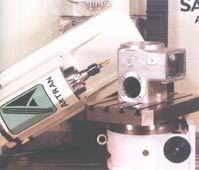Automating Multiple Face Machining
Although multiple face machining in a single setup is possible with four-axis machines, these machines only meet the positioning requirements for a small range of parts. To have the capability for programming multi-plane machining-and to machine this type of part in a single setup-a five-axis machine is necessary.
Share







Takumi USA
Featured Content
View More
Hwacheon Machinery America, Inc.
Featured Content
View More
Many of today’s machined parts incorporate various features located on multiple planes or faces of the parts. When using a three-axis mill or machining center to produce such parts, multiple setups are necessary. Additionally, some parts require complicated and expensive fixtures on which parts must be precisely oriented. Furthermore, each time a part is transferred from one fixture to another, the potential positioning error increases.
Although multiple face machining in a single setup is possible with four-axis machines, these machines only meet the positioning requirements for a small range of parts. To have the capability for programming multi-plane machining—and to machine this type of part in a single setup—a five-axis machine is necessary.
Considering the advantages of five-axis machines, it might seem odd that more machine shops aren’t using them. In the past, however, five-axis machines have been quite expensive. Also, these machines may be very difficult to program or severely limited in the range of parts they can handle, or both. For example, a conventional machining center that employs a tilting rotary table to achieve five-axis capability has strict size and load limitations. Factors such as stack height, angular errors and limited part access can lead to substantial inaccuracies. For these reasons, demand for five-axis machines has been limited primarily to applications that require simultaneous, five-axis machining. In general, this market has not reflected the needs of shops performing multiple face machining.
Artran (Springdale, Arkansas) says its line of universal machines addresses these drawbacks by offering five-axis capability at economical prices. These machines are designed to optimize part accessibility, programming and setup.
The drawing on this page illustrates the tool positioning factors addressed by Artran’s automatic Contour control. The sketched part incorporates a 1-inch-deep hole machined into one face that is oriented on a compound angle (a plane that is rotated around more than one of the X, Y and Z axes). The part is located on a C-axis rotary table, and the five-axis machine is equipped with a pivoting (B-axis) head. The machine control addresses three principal programming challenges. First, when the toolhead rotates on the B axis to an inclination parallel to the desired hole, this movement alters the tool tip’s X and Z coordinates. This change occurs even when the tool tip is very close to the tool’s rotational axis. The Contour machine control incorporates a Tool Tip Maintenance feature that resembles a three dimensional tool length compensation function. This control automatically maintains the correct X and Z coordinates, regardless of the particular toolhead inclination. This eliminates the need to manually calculate the tool tip location or re-post the CAM system when the tool length is changed.
Second, as the part is rotated on the C-axis table, the coordinates of its various features change in relation to the original XY axes. To address this complexity, the control’s C-axis Coordinate Maintenance function automatically rotates the original XY coordinates as the part rotates. The control keeps track of C-axis rotation relative to the machine’s home position at all times. This eliminates the necessity of transforming every XY coordinate in the part program. Even when these calculations are performed by a CAM system, the operator still must precisely position the part on the table. This is critical because, when the G-code file is posted, the CAM system must receive the exact position of the part in reference to its rotational axis. Accurately positioning the part can be a time consuming process that represents another variable adding to potential part error.
Third, a new zero point must be defined at the top center of the hole to be machined, and the tool must be moved to a clearance position just above the hole’s center. The Contour control allows this location data to be taken directly from the part blueprint without requiring manual calculations.
Because the machine control makes all canned cycles, cutter-radius compensation and other functions available regardless of which part plane is machined, it substantially simplifies programming and reduces file overhead for part programs. Combined with Artran’s affordable five-axis machining centers, this control system enables shops to economically produce a broad range of multiple-face parts using single setups.
Related Content
How to Successfully Adopt Five-Axis Machining
While there are many changes to adopt when moving to five-axis, they all compliment the overall goal of better parts through less operations.
Read MoreThe Future of High Feed Milling in Modern Manufacturing
Achieve higher metal removal rates and enhanced predictability with ISCAR’s advanced high-feed milling tools — optimized for today’s competitive global market.
Read MoreQuick-Change Tool Heads Reduce Setup on Swiss-Type Turning Centers
This new quick-change tooling system enables shops to get more production from their Swiss turning centers through reduced tool setup time and matches the performance of a solid tool.
Read MoreCNC Machine Shop Honored for Automation, Machine Monitoring
From cobots to machine monitoring, this Top Shop honoree shows that machining technology is about more than the machine tool.
Read MoreRead Next
5 Rules of Thumb for Buying CNC Machine Tools
Use these tips to carefully plan your machine tool purchases and to avoid regretting your decision later.
Read MoreRegistration Now Open for the Precision Machining Technology Show (PMTS) 2025
The precision machining industry’s premier event returns to Cleveland, OH, April 1-3.
Read MoreBuilding Out a Foundation for Student Machinists
Autodesk and Haas have teamed up to produce an introductory course for students that covers the basics of CAD, CAM and CNC while providing them with a portfolio part.
Read More

















































